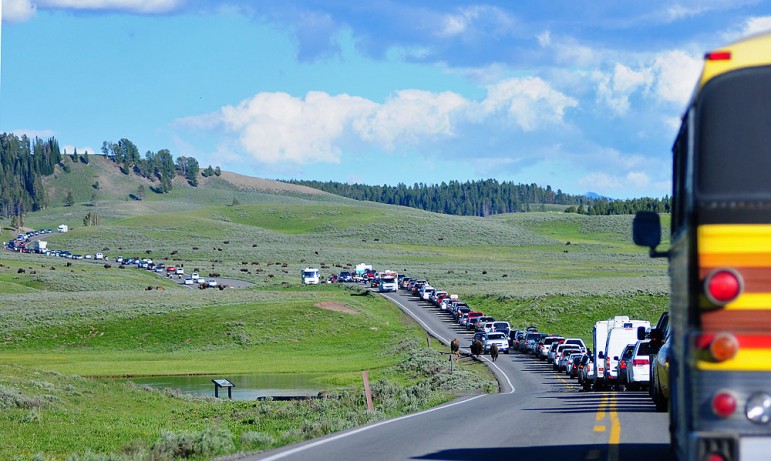
CODY, WYO. — More people visited Yellowstone National Park last month than any other September on record, and the park has set a new annual visitation record, with nearly three months still remaining before the end of the year.
More than 3.8 million people have visited Yellowstone through the end of September, according to figures compiled by the National Park Service. That shatters the previous annual record of 3.6 million visitors in 2010. And if October follows recent trends, Yellowstone could log more than 4 million visitors by the end of 2015.
The increased traffic is bringing more international and urban tourists to Yellowstone, posing new challenges for how to keep visitors safe amidst 2.2 million acres filled with wild animals, scalding geysers, steep canyons and more vehicles than ever before.
Five tourists were injured this year by bison, including some who got too close while attempting to take photos with the large, unpredictable animals. A man hiking alone and off-trail in August was killed by a grizzly bear, with park officials later capturing and euthanizing the bear, which they said had behaved uncharacteristically.
Last month brought 680,213 recreational visitors to Yellowstone. That’s 19 percent higher than September 2014, which was previously the busiest September on record.
So far this year, total recreation visitation in the park is up 16 percent over last year.
Yellowstone spokeswoman Julena Campbell said the busy year has been obvious based on long lines at entrances and in parking lots around Yellowstone.
“Just moving around the park, you could feel how busy it was, you could see it,” she said.
Campbell said it wasn’t clear whether the increased numbers “are an anomaly or the new normal.”
But the bigger crowds in September appear to be part of a well-defined trend in Yellowstone that has been building for some time.
For the decade from 2000-09, Yellowstone saw an average of 416,481 visitors during September. Since 2010, September has averaged 570,727 visitors, an average increase of 37 percent.
That’s thanks in part to efforts by the National Park Service, state tourism boards and local industry leaders to promote September and October as a “shoulder season” when visitors can book at lower rates, enjoy decent weather and watch wildlife and fall colors without the summer crowds.
Campbell said the Park Service will be increasing its efforts to offer online trip planning information and other assistance for fall visitors as a way to steer some visitor traffic away from the peak summer months.
July was the busiest single month ever in Yellowstone, with 980,702 recreational visitors, a 14 percent increase over July 2014.
Head counts in Yellowstone and other national parks are actually sophisticated estimates based on an average number of people arriving in each vehicle, using numbers the Park Service continually refines as it gathers data from surveys and other sources, Campbell said.
Yellowstone Superintendent Dan Wenk is planning to visit gateway communities in the coming months to discuss ways to alleviate some of the peak summer congestion at park entrances and in other places, Campbell said.
Lodging taxes in Park County, Wyoming, at the park’s East Entrance, were up more than 11 percent for the year through July, the latest month for which numbers were available, said Claudia Wade, marketing director for the Park County Travel Council.
“For the most part, it has been a very positive season,” Wade said. “Everybody’s numbers are pretty much up.”
While the bump in numbers helped hotels in gateway communities around the park, it didn’t amount to a major lodging windfall for Xanterra Parks & Resorts, the concessioner that operates hotels inside Yellowstone.
Hotel rooms and campsites in Yellowstone usually run at close to full occupancy for much of the summer, so “increased visitation doesn’t typically mean a change in how many we can accommodate in lodging,” said Rick Hoeninghausen, director of sales and marketing for Xanterra.
But bigger crowds help Xanterra’s sales at gift shops and restaurants in the park, Hoeninghausen said, and company employees coped well with the record year.
“Where we observed the biggest impacts were places like parking near geyser basins, or in parking areas near hotels during the day,” he said. “People are running out of options and sometimes just end up parking along the roads.”
More traffic puts a strain on park resources, but it also results in more fees collected at park gates. Yellowstone could end up taking in an additional $4.5 million this year from increased entrance fees and higher visitor numbers, Campbell said.
Most of Yellowstone’s roads close Nov. 2 in preparation for the winter travel season, which begins Dec. 15. Winter visitation makes up only a small part of the park’s annual total, usually topping out at around 6 percent.
Contact Ruffin Prevost at 307-213-9818 or [email protected].

My observation is there is a HUGE infusion of international tour busses. The experience of Yellowstone is tainted as 100 tourist with selfies sticks run out at each location … Take selfies and then proceed to the next stop. The caravan of masses is ruining the experience of YNP. What to do? What to do?